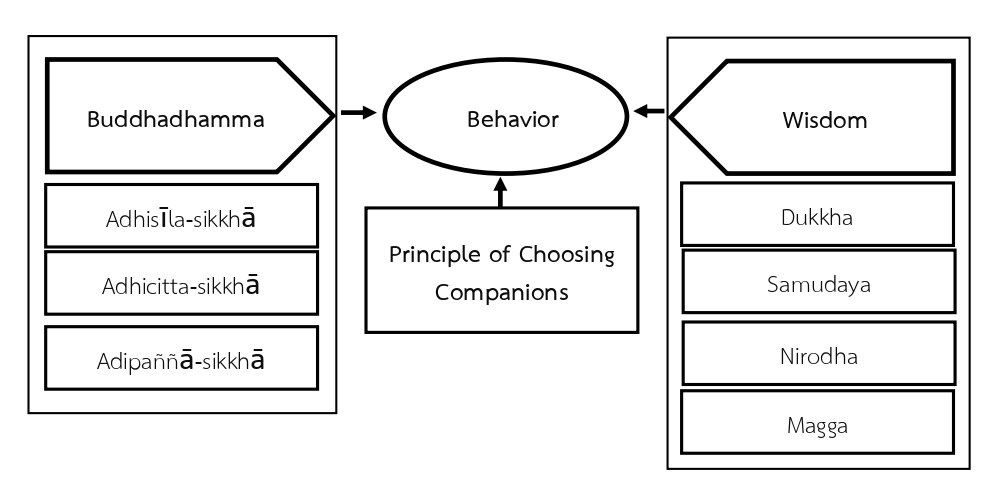THE APPLICATION OF BUDDHIST PRINCIPLES TO SOLVING THE MISUSE OF TRAMADOL
Keywords:
Buddhist Principles, Misuse, TramadolAbstract
Background and Objectives: The problems children and youths encountered evolved in response to the current global landscape. Disturbing trends included an increase in the concurrent use of multiple drugs, rendering treatment more complex than in the past. Furthermore, youngsters were mixing various easily accessible substances to replicate the effects of drugs. This behavior often disregarded the addictive nature of these substances. Children and youths fell into a high-risk category due to their natural curiosity, inclination to experiment, limited experience, and underdeveloped judgment, leading to potentially inappropriate decisions and behaviors. The particular concern was the widely popular drug "Tramadol", classified as a dangerous substance due to its morphine-like effects. This research aimed to study the situation of misuse of Tramadol in children and youths, the influencing factors to the misuse of Tramadol, its impact, and guidelines for solving the misuse of Tramadol.
Methodology: This qualitative research employed in-depth interviews with individuals who consumed dangerous drugs like Tramadol. The participants included both males and females and fell under the jurisdiction of the Training Center for Children and Youth.
Main Results: Children and youths were increasingly inclined to misuse Tramadol due to its wide availability and affordability. Legal gaps had been used to smuggle illegal Tramadol to children and youths. Influencing factors included peer groups, curiosity, a desire to experiment, lack of discernment, and impulsiveness based on age. The drug could have provided a channel for imagination and fulfillment. Among children and youths who misused Tramadol, there existed a colloquial expression that captured the sensation it brought: "to the vastness and distance". Tramadol evolved into a quiet menace, transforming into a social problem by inducing mental instability, recklessness, and poor decision-making.
Involvement to Buddhadhamma: The application of Buddhist principles, as Buddha taught, can address this issue. Specifically, the Ti-Sikkhā principle (Threefold Training) encompassing Adhisīla-sikkhā (Refraining from evil), Adhicitta-sikkhā (Intention to do good), and Adipaññā-sikkhā (Purification of the mind), along with the four Suhadamitta principles (True Friends): Upakāraka-mitta (The supportive friend), Samānasukhadukkha-mitta (The friend who remains steadfast in times of joy and sorrow), Atthakkhāyī-mitta (The friend who offers sound counsel), and Anukampaka-mitta (The empathetic friend). These principles can be applied through the Four Noble Truths (Ariyasacca): Dukkha (Suffering), Samudaya (Origin), Nirodha (Cessation), and Magga (path) to comprehend the underlying causes. This understanding aims to protect children and youths from harm, ensuring their rights and a stable, high-quality life. By nurturing these principles, young individuals can become valuable citizens, forming the bedrock of the nation's future.
Conclusions: The misuse of Tramadol among children and youths of Generation Z, often referred to as Gen Z, where it was being treated similarly to a narcotic substance, represented a subtle yet escalating societal concern. Consequently, there was a pressing need to apply Buddhist principles to establish a foundation for prevention and resolution. Specifically, the Ti-Sikkhā principle (Threefold Training) and the principle of choosing good friends should have been embraced. These principles worked in tandem to shape the conduct of children and youths, fostering desirable behaviors and imparting the ability to utilize wisdom when addressing various challenges. This approach aimed to reinforce behaviors that aligned with their age and cultivated qualities that adhered to societal norms.
References
Angtrakul, P. (2016). Warning "Tramadol" misuse to death, pharmacies strictly controlled, selling not exceeding 20 tablets. Thairath.
Bunpen, K. (2018). Thai children who are addicted to screens, 46% have been bullied online. Khom Chat Leuk.
Chairat, P. (2017). Dhamma Principles for the Prevention and Solution of Youth Drug Problems. Journal of Philosophical Vision, 22(1), 13-27.
Komalo, P. (2018). An Analytical Study of Approaches to Solving Drug Problems according to Buddhist Principles. [Master's thesis, Mahamakut Buddhist University]. Thesis Central Library Mahamakut Buddhist University. http://www.opac.mbu.ac.th/MyResearch/pfile/2192/9759.pdf.
Mahachulalongkornrajavidyalaya University. (1996). Thai Tripitaka. Bangkok: Mahachulalongkornrajavidyalaya University Printing Press.
National Statistical Office. (2016). Inspection Information 2014. Ministry of Digital Economy and Society.
Office of the Narcotics Control Board Bangkok. (2017). Narcotic drug situation in Bangkok area in 2017 and its tendency in 2018. Office of the Narcotics Control Board Ministry of Justice.
Raksasat A. (2017). Training of the Trainers in Palliative Care. (1st ed.). Klang Nanawittaya Printery.
Sirisupakritkul, N., Akrawut, W., & Sawetsila, S. (2013). Tramadol, A Drug that Should be Watched Out for Misuse. Journal of Center for Quality Collection, 16(2), 1-2.
Tripathi, S. (2017). Cost of life for Thai Children and Youth. BKK Pro.

Downloads
Published
How to Cite
Issue
Section
License
Copyright (c) 2023 Journal of Buddhist Anthropology

This work is licensed under a Creative Commons Attribution-NonCommercial-NoDerivatives 4.0 International License.







